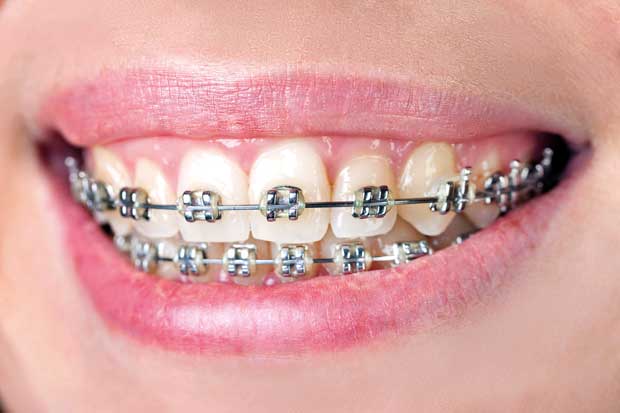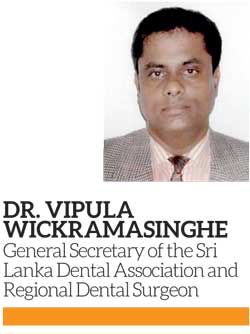Reply To:
Name - Reply Comment

 Dental issues do not merely cause problems for health, but may affect your appearance as well. What happens when your teeth become more forward than you are? You are in trouble of course! A protruding set of teeth should tell you that it’s time to visit your dental surgeon. You may dread wearing braces; everyone’s childhood nightmare. However it will be worth it once the treatment is complete. Dr. Vipula Wickramasinghe, General Secretary of the Sri Lanka Dental Association and Regional Dental Surgeon of the Colombo District, spoke to the Health Capsule and shed light on the treatment procedure.
Dental issues do not merely cause problems for health, but may affect your appearance as well. What happens when your teeth become more forward than you are? You are in trouble of course! A protruding set of teeth should tell you that it’s time to visit your dental surgeon. You may dread wearing braces; everyone’s childhood nightmare. However it will be worth it once the treatment is complete. Dr. Vipula Wickramasinghe, General Secretary of the Sri Lanka Dental Association and Regional Dental Surgeon of the Colombo District, spoke to the Health Capsule and shed light on the treatment procedure.
“Braces are used to correct the malalignment of the teeth. A diagnosis of whether the malocclusion should be corrected or not should be made first. There are certain conditions which may seem like malocclusions, but are perfectly normal. If there is a correction to be made in the positioning of teeth it can be done in several ways,” he stated.
He further added that braces are not resorted to if it can be helped. Sometimes certain types of malocclusions can be corrected without braces with just a removable type of plates. There are other conditions of malocclusions which need braces while others require surgical approach which is then followed by braces. Orthodontics plus surgery are required.
If the malocclusion is only a small issue, a general dental surgeon will be able to diagnose and recommend treatment. If the problem is a bit severe, the patient will be directed towards an orthodontist who is specialized in braces and treatments. “It is an aesthetic oriented treatment. Spaces between teeth, clock line teeth, longer teeth and gaps between dental arches can be corrected by using braces,” said Dr. Wickramasinghe.
Causes
According to Dr. Wickramasinghe, there are certain causes for malalignment of teeth. “A clock line set of teeth can be genetically inherited from parents to children. Certain habits also cause the malalignment of the teeth. Thumb sucking, using pacifiers during childhood as well as biting on pencils, breathing through the mouth can lead to malalignment. The premature extraction of deciduous teeth untimely or even the extraction of permanent teeth can also lead to deformities in the positioning of the teeth. These are the typical basic causes for malocclusion,” he warned.
“The general advice given to parents by a dental surgeon is that if they notice any form of malalignment of the teeth, then the child should be directed towards a medical professional. Parents are advised not to arrive at a diagnosis on their own. Go to a dental surgeon and get a professional diagnosis and make a proper decision on the treatment, if it’s needed. A dental surgeon is normally able to understand and identify the complications of the malalignment. If the malocclusion is more complex, the patient will be directed towards an orthodontist. If you feel you have a malocclusion you are free to consult a dental surgeon at any time without making a diagnosis yourself,” stressed Dr. Wickramasinghe.
Never too old for treatment
It should be kept in mind that there is no specific age to visit a dentist and get a diagnosis for malocclusion. It is true that there are certain condition treatments which may have to start at a specific age due to various reasons. However, this is a decision for the dental surgeon to make. There is a common myth that malalignments can only be treated in children between the ages of 12-15. This is not true. A spurt of growth is observed in the age groups within 12-18 which is considered the best period to correct teeth. However this does not mean that once this age is exceeded malocclusions cannot be corrected. Late 25-30 and even a good set of teeth at 40 can be set correctly using braces. Age doesn’t matter. Normally the period of the spurt of growth is recommended for treatment as the duration or the treatment reduces during this period as correction takes place quickly during the growth years.
“Before braces are inserted, X-rays of the patient’s jaw are needed. Sometimes the extraction of teeth are needed to make space before using braces to push back the teeth. Teeth should be cleaned and polished before braces are inserted during treatment. Before and during the treatment oral hygiene is vital. Caries, tartar and plaque have to be cleaned. Fillings should be performed if necessary before braces are inserted,” explicated Dr. Wickramasinghe.
Treatment
“Treatment for malalignments include removable plates, braces or surgery and braces. The treatment of malocclusions by using braces is usually performed under the supervision of an orthodontist. It is a dynamic process and you should go to a specialized person to get this kind of treatment. The idea of the correction using braces is 100% based on the movement of the teeth by applying a force. It is not just pushing back the teeth, but the gross movement of teeth even from the roots itself using the force. Additional force can lead to damage of the teeth. Hence it is an extremely tricky treatment. Before the outset of brace treatment, the procedure should be explained to the patient beforehand. Simple complications that can be corrected by braces can be handled by general dental surgeons. However the more complex issues need to be directed towards an orthodontist. The big state hospitals have this service with well-developed fully functional orthodontist units available free of charge. Treatment can be obtained from the private sector as well, but it is more costly,” he added.
He stressed that braces come in various forms. Braces with metallic wires, coloured wires or even braces can be set behind the teeth so that people are unaware of the fact that you are wearing braces are currently available. The period during which you have to wear the braces may vary according to the severity of the malocclusion. Uncomplicated cases usually require about 1-1 and a 1/2 years of treatment. More complex cases may extend treatment for 2-21/2 years. The orthodontist should be frequently visited once a month for checkups. The braces cannot be removed in the middle of treatment. If so, the treatment cannot be continued from where it was stopped. You are left on square one and the treatment has to be started from the beginning. Therefore, before treatment is commenced it’s important to talk to the patient about the procedure, time period of treatment and cost. Once they comply the procedure will be started.
Maintenance during treatment
Due to the development of current techniques, the outcome of the treatment given can be predicted and shown to the patient, so that the patient is informed of the kind of appearance he or she will get after the treatment. Dr. Wickramasinghe stressed that while wearing braces it is important to pay attention to the maintenance of proper and strict oral hygiene. “Brushing of teeth properly, using a fluoridated tooth paste, using interdental brushes are some facts to remember. It is very important to clean the space between the wire and teeth. 100% oral hygiene is necessary or the tendency to develop unnecessary caries is quite high when wearing braces,” he warned.
“Orthodontics and braces have come a long way in terms of development. On the other hand it may cost a lot of money. It is a huge commitment with frequent visits to the dental surgeon as it is an aesthetic oriented treatment. However the outcome received is 100% favourable. Get appropriate advice from the dentist. If and only if braces are recommended, start treatment as early as possible without delay,” advised Dr. Wickramasinhe on a final note.